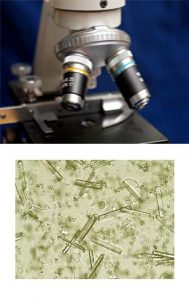Why Are There Struvite Crystals In My Dog Or My Cat’s Urine?
Ron Hines DVM PhD
 See What Normal Blood & Urine Values Are
See What Normal Blood & Urine Values Are
 Causes Of Most Abnormal Blood & Urine Tests
Causes Of Most Abnormal Blood & Urine Tests
What Does It Mean When Struvite Crystals Are Seen In My Pet’s Urine?
This entry in many respects duplicates one on crystals sometimes seen in your pet’s urine. Read that one here.
At one time, struvite crystals (aka magnesium ammonium phosphate or triple phosphate) formed the majority of urinary tract stones (calculi) occurring in dogs and cats. These crystals were particularly dangerous when they formed a sandy, gritty material that sometimes obstructs the penis of male cats (FUS). Generally, those are cats that were neutered at a young age and/or overweight. In dogs, struvite more frequently forms large bladders stones that cause urgency and pain in female dogs. Struvite-based urinary tract stones are still quite common. However, oxalate-based stones now account for at least as many calculi/stone cases in pets. Veterinarians are unsure why.
Struvite crystals tend to form when your pet’s urine is not acidic enough and when it is overly concentrated as a result of your dog or cat not drinking enough water throughout the day. Although unproven, many veterinarians associate the feeding of dry dog and cats chows with the chronic dehydration and concentrated urine conducive to urinary tract stone formation. Certain bacteria also split the urea present in urine into ammonia. When those bacteria are present, they make the urine basic (alkaline) enough for struvite crystals to form.
Reason Why Your Cat or Dog Might Form Struvite Crystals In Its Urine:
The fact that your veterinarian observes fine struvite crystals in your dog’s urine is not necessarily a sign of disease or that problems will occur in the future. I find them considerably more worrisome when they are seen in the fresh urine of cats. The wider urethra of female cats prevents life-threatening urine obstruction. But when the problem occurs in male cats it often prevents them from urinating successfully. That is life-threatening.
Not enough liquids consumed during the day is probably the most common cause for benign (unimportant) struvite crystals being observed in your dog or cat’s urine. Unimportant crystals are also more likely to be seen when your pet’s urine sample sat on the table at room temperature for too long before being examined.
A basic pH urine is conducive (encourages) to struvite crystal formation. That would be a urine sample with a pH greater than 7. As I mentioned, it is common for dogs and cats with basic urine to have a urinary tract infected with bacteria that split urine urea (urease-positive bacteria) into the more basic, ammonia.
It might also be possible for pets, encouraged to eat a bizarre vegan-type diet, to have a more basic urine. Plant proteins-based diets tend to produce basic urine. That might make it more likely to contain precipitate struvite crystals that have precipitated out of solution. Little nutritional research goes into the formulation of those vegan diets and their long-term effect on pet health is unknown. Relying primarily on soy protein and beans, rather than meat, to meet a carnivore’s protein requirements is never a good idea.
Complementary Tests:
Compete urinalysis, CBC/ WBC and blood chemistry panel. Urine bacterial culture. Antibiotic sensitivity tests on any bacteria are recovered, A review of your dog or cat’s diet. Observation of the adequacy of your pet’s liquids consumption during the day. If urinary urgency or difficulties are already present, bladder/kidney x-rays and perhaps more sophisticated contrast studies.
DxMe
 Dear reader, Besides your donations, Visiting the products that Google chooses to display on this webpage helps me pay the cost of keeping this article on the Web. As you know, sites like mine that are not designed to make money are getting harder and harder to find. Best wishes, Ron Hines
Dear reader, Besides your donations, Visiting the products that Google chooses to display on this webpage helps me pay the cost of keeping this article on the Web. As you know, sites like mine that are not designed to make money are getting harder and harder to find. Best wishes, Ron Hines



